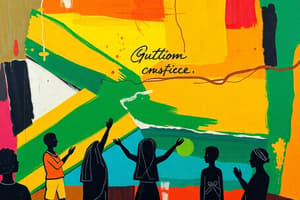Podcast
Questions and Answers
What was the primary concern of the black majority in the new South African democracy?
What was the primary concern of the black majority in the new South African democracy?
The primary concern was to ensure that the democratic principle of majority rule was not compromised.
What compromise was reached between the black and white populations regarding majority rule?
What compromise was reached between the black and white populations regarding majority rule?
The compromise established that majority rule would not be absolute and the property of the white minority would not be taken away.
Why did both parties recognize the necessity of a constitution?
Why did both parties recognize the necessity of a constitution?
Both parties recognized the need for a constitution to safeguard their interests and to provide a framework for governance.
What specific rights did the white minority seek to protect in the negotiations?
What specific rights did the white minority seek to protect in the negotiations?
How did the black majority and white minority ensure that their trust could be maintained in the new democracy?
How did the black majority and white minority ensure that their trust could be maintained in the new democracy?
What was the significance of 'one person, one vote' in the compromise reached?
What was the significance of 'one person, one vote' in the compromise reached?
What is the role of a constitution in a country according to the text?
What is the role of a constitution in a country according to the text?
What was a significant challenge in creating the Indian Constitution?
What was a significant challenge in creating the Indian Constitution?
How did the freedom struggle influence the making of the Indian Constitution?
How did the freedom struggle influence the making of the Indian Constitution?
What does the transition from subjects to citizens imply in the context of India's independence?
What does the transition from subjects to citizens imply in the context of India's independence?
What role did Vallabhbhai Patel play in the making of the Indian Constitution?
What role did Vallabhbhai Patel play in the making of the Indian Constitution?
What does the term 'Consensus' refer to in the context of the making of the Indian Constitution?
What does the term 'Consensus' refer to in the context of the making of the Indian Constitution?
What was the impact of partition on the Constitution-making process in India?
What was the impact of partition on the Constitution-making process in India?
Why is having a written constitution considered important in a democracy?
Why is having a written constitution considered important in a democracy?
How did the diversity of India present challenges to the Constitution's framers?
How did the diversity of India present challenges to the Constitution's framers?
What are some of the sharp differences of opinion that existed during the freedom struggle regarding the future of India?
What are some of the sharp differences of opinion that existed during the freedom struggle regarding the future of India?
What common idea can be identified in the quotes from Sarojini Naidu and Somnath L Lahiri?
What common idea can be identified in the quotes from Sarojini Naidu and Somnath L Lahiri?
How does Sarojini Naidu emphasize the need for action in her statement?
How does Sarojini Naidu emphasize the need for action in her statement?
What is the significance of the 'Preamble' in the Indian Constitution?
What is the significance of the 'Preamble' in the Indian Constitution?
In what way does Somnath Lahiri reflect the values of the Communist Party in his quote?
In what way does Somnath Lahiri reflect the values of the Communist Party in his quote?
What role did ideas of social justice play in India’s freedom struggle according to the content?
What role did ideas of social justice play in India’s freedom struggle according to the content?
What role did the British play in the merger of princely states with India or Pakistan?
What role did the British play in the merger of princely states with India or Pakistan?
What was the significance of the 1931 Karachi session of the Indian National Congress?
What was the significance of the 1931 Karachi session of the Indian National Congress?
How did the violence of partition affect population demographics in the region?
How did the violence of partition affect population demographics in the region?
Who was Motilal Nehru, and what contribution did he make to the constitutional framework of India?
Who was Motilal Nehru, and what contribution did he make to the constitutional framework of India?
What fundamental values were included in the documents related to India’s independence?
What fundamental values were included in the documents related to India’s independence?
Describe the anxieties of the makers of the Indian constitution regarding the future of the country.
Describe the anxieties of the makers of the Indian constitution regarding the future of the country.
What was the primary challenge faced during the integration of princely states?
What was the primary challenge faced during the integration of princely states?
What role did Abul Kalam Azad play in the Indian National Movement?
What role did Abul Kalam Azad play in the Indian National Movement?
How was the concept of minority rights incorporated into India's constitution?
How was the concept of minority rights incorporated into India's constitution?
In what context did the word 'integration' arise during discussions of India's independence?
In what context did the word 'integration' arise during discussions of India's independence?
What was the purpose of the Constituent Assembly in India?
What was the purpose of the Constituent Assembly in India?
When were the elections for the Constituent Assembly held?
When were the elections for the Constituent Assembly held?
What inspired many Indian leaders in framing the Constitution?
What inspired many Indian leaders in framing the Constitution?
What is significant about the date January 26 in India?
What is significant about the date January 26 in India?
How many members were part of the Constituent Assembly that wrote the Indian Constitution?
How many members were part of the Constituent Assembly that wrote the Indian Constitution?
What is the historical significance of the meeting that took place in December 1946?
What is the historical significance of the meeting that took place in December 1946?
Who was the first President of the Constituent Assembly?
Who was the first President of the Constituent Assembly?
What does the adoption of the Constitution on November 26, 1949, signify?
What does the adoption of the Constitution on November 26, 1949, signify?
In what ways did colonial laws influence the Indian Constitution?
In what ways did colonial laws influence the Indian Constitution?
What impact did the socialist revolution in Russia have on Indian leaders?
What impact did the socialist revolution in Russia have on Indian leaders?
Flashcards
What is a constitution?
What is a constitution?
A document that outlines the fundamental principles, laws, and rights of a country. It acts as a blueprint for governance, outlining how power is distributed, how decisions are made, and protecting individual rights.
What is compromise in constitutional design?
What is compromise in constitutional design?
A process where different groups with conflicting interests negotiate and agree on a set of compromises. This process involves finding common ground and making concessions to achieve a mutually acceptable solution.
Majority rule in constitutional design
Majority rule in constitutional design
The principle of majority rule, where the decisions made by the majority of the population are binding on the entire population. It's a core principle of democracy, ensuring that the will of the majority is reflected in government decisions.
Basic rights in constitutional design
Basic rights in constitutional design
Signup and view all the flashcards
How are constitutional principles implemented?
How are constitutional principles implemented?
Signup and view all the flashcards
The South African example of constitutional design?
The South African example of constitutional design?
Signup and view all the flashcards
Equality in constitutional design?
Equality in constitutional design?
Signup and view all the flashcards
Constitution
Constitution
Signup and view all the flashcards
Democracy
Democracy
Signup and view all the flashcards
Constitution Making
Constitution Making
Signup and view all the flashcards
Nation-building
Nation-building
Signup and view all the flashcards
Partition
Partition
Signup and view all the flashcards
India's Independence
India's Independence
Signup and view all the flashcards
India's Freedom Struggle
India's Freedom Struggle
Signup and view all the flashcards
Differences of Opinion
Differences of Opinion
Signup and view all the flashcards
Rationalization
Rationalization
Signup and view all the flashcards
Integration of Princely States
Integration of Princely States
Signup and view all the flashcards
Partition Related Violence
Partition Related Violence
Signup and view all the flashcards
Universal Adult Franchise
Universal Adult Franchise
Signup and view all the flashcards
Anxieties about the Future
Anxieties about the Future
Signup and view all the flashcards
Rights to Freedom and Equality
Rights to Freedom and Equality
Signup and view all the flashcards
Protecting Minority Rights
Protecting Minority Rights
Signup and view all the flashcards
Basic Values Accepted by Leaders
Basic Values Accepted by Leaders
Signup and view all the flashcards
Constituent Assembly
Constituent Assembly
Signup and view all the flashcards
Abul Kalam Azad
Abul Kalam Azad
Signup and view all the flashcards
What is the Preamble?
What is the Preamble?
Signup and view all the flashcards
What inspired India's constitutional values?
What inspired India's constitutional values?
Signup and view all the flashcards
What is the significance of the Preamble of the Indian Constitution?
What is the significance of the Preamble of the Indian Constitution?
Signup and view all the flashcards
What is meant by 'taking inspiration from American model'?
What is meant by 'taking inspiration from American model'?
Signup and view all the flashcards
What are Constitutional values?
What are Constitutional values?
Signup and view all the flashcards
Constitutional Design
Constitutional Design
Signup and view all the flashcards
Government of India Act, 1935
Government of India Act, 1935
Signup and view all the flashcards
When was the Indian Constitution Passed?
When was the Indian Constitution Passed?
Signup and view all the flashcards
When did the Indian Constitution take effect?
When did the Indian Constitution take effect?
Signup and view all the flashcards
Inspirations for India's Constitution
Inspirations for India's Constitution
Signup and view all the flashcards
Social and Economic Equality in Indian Constitution
Social and Economic Equality in Indian Constitution
Signup and view all the flashcards
Who was the first President of the Constituent Assembly?
Who was the first President of the Constituent Assembly?
Signup and view all the flashcards
How many members in the Constituent Assembly?
How many members in the Constituent Assembly?
Signup and view all the flashcards
Division of India and Pakistan impact on the Constituent Assembly
Division of India and Pakistan impact on the Constituent Assembly
Signup and view all the flashcards
Study Notes
Constitutional Design
- In a democracy, rulers are not free to do as they please. Basic rules, called the constitution, outline citizens' rights, governmental powers, and how the government operates.
- This chapter explores questions about constitutional design in democracies. Why do we need a constitution? How are constitutions created? Who designs them and by what methods? What values shape democratic constitutions? Can changes be made after a constitution is adopted?
- South Africa's recent constitution-making process is examined as a case study, along with the creation of the Indian constitution and its foundational values. These provide frameworks for the conduct of citizens' lives and the functioning of government respectively.
Democratic Constitution in South Africa
- Apartheid, a unique system of racial discrimination, characterized South Africa.
- The white population established this system (which impacted all non-white communities).
- Black South Africans (making up three-fourths of the population) held no voting rights. They faced restrictions on where they could live, work, and access various services (education, housing, etc).
- Nelson Mandela and other leaders actively opposed apartheid.
- Mandela's trial for treason (1964) highlighted ongoing racial injustices.
- The struggle against apartheid, including protests and strikes, eventually led to a new South African constitution, emphasizing reconciliation and equality.
- Mandela and other South African leaders emphasized the importance of forgiveness and reconciliation to shape the post-apartheid period.
- The new constitution sought to address the injustices of the past fairly and with equality for all citizens.
Making of the Indian Constitution
- The creation of a constitution for India was challenging.
- The country's diversity and emergence from colonial rule presented significant complexities.
- The country was divided based on religious differences (this presented substantial challenges)
- The Indian constitution’s origin was rooted in numerous discussions, ideas, and compromises. The process of creating the constitution was rigorous and thorough, considering suggestions and amendments that reflected the diverse voices and perspectives across the country. This process ensured that the constitution was accepted by a vast majority of people and groups across India’s society.
- Leaders, including Motilal Nehru and other Congress leaders, developed documents outlining the constitution's framework and principles in 1928 and 1931, demonstrating early input into the process.
- The Constituent Assembly worked systematically to create the constitution (deciding principles first, then developing a draft constitution, and subjecting the draft to extensive debate and revisions from numerous participants).
- The Assembly's work is regarded as legitimate.
Philosophy of the Indian Constitution
- The preamble to the Indian constitution states the essential values (justice, liberty, equality, and fraternity) that inspire the document, outlining a vision for a fair and inclusive society.
- The preamble was adopted to guide and inspire the constitution’s various articles.
Institutional Design
- A constitution defines the structure of government, including laws and procedures for the political process.
- The Indian Constitution (which contains institutional provisions) outlines the rules and procedures for the functioning of the state, determining who will hold power and how that power will be exercised.
- The constitution details the specific powers of government institutions and individuals. These descriptions serve as a critical reference point.
- The amendments to the constitution outline the mechanisms for modification. This process allows for adjustments in response to societal shifts and evolving needs.
Studying That Suits You
Use AI to generate personalized quizzes and flashcards to suit your learning preferences.




